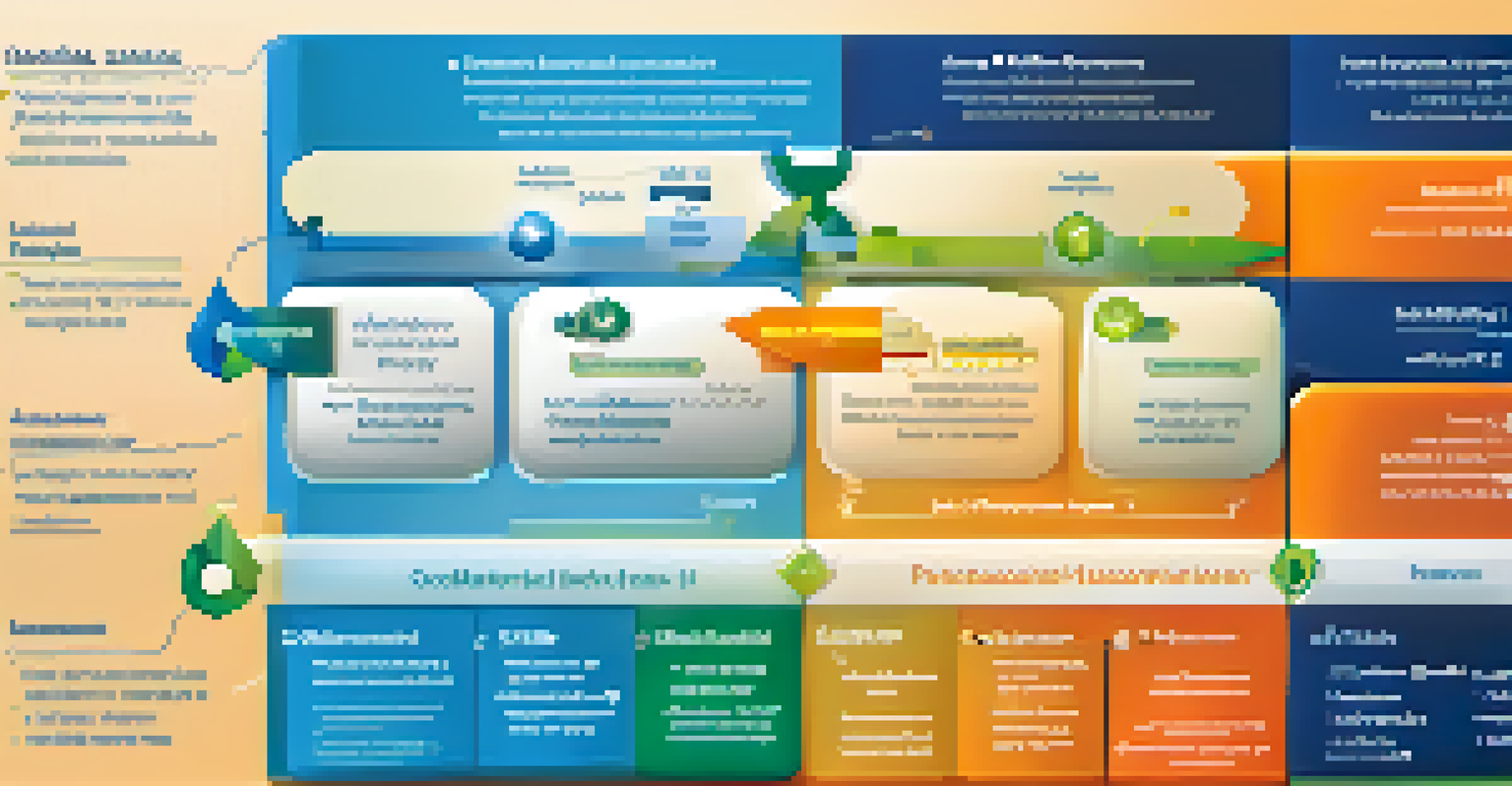Pharmaceutical Value Assessment: Methods and Challenges

What is Pharmaceutical Value Assessment?
Pharmaceutical value assessment is a systematic approach used to evaluate the worth of a drug based on various criteria. It encompasses not just the drug's effectiveness but also its safety, cost-effectiveness, and overall impact on patient health. By considering multiple factors, stakeholders can make more informed decisions regarding drug pricing and reimbursement.
The greatest value of a pharmaceutical product is not just in its price, but in the outcomes it delivers to patients.
This assessment is crucial for healthcare providers, payers, and policymakers as it helps them understand the economic and clinical value of new therapies. For instance, a high-priced medication may be justified if it significantly improves patient outcomes compared to existing treatments. Ultimately, it aims to ensure that patients have access to effective therapies while managing healthcare costs.
In an era of rising drug prices, the importance of pharmaceutical value assessment has become even more pronounced. By focusing on value rather than just cost, the healthcare system can strive for a balance between innovation and affordability.
Key Methods of Value Assessment in Pharmaceuticals
Several methods are employed to assess the value of pharmaceuticals, including cost-effectiveness analysis (CEA), budget impact analysis (BIA), and quality-adjusted life years (QALYs). Cost-effectiveness analysis compares the relative costs and outcomes of different treatment options, helping stakeholders determine which therapies provide the best value. For example, if Drug A costs more than Drug B but offers significantly better outcomes, CEA can highlight this difference.

Budget impact analysis, on the other hand, estimates the financial implications of adopting a new drug within a specific budget context. This method is particularly useful for healthcare payers who need to understand how a new therapy will affect their overall budget. By combining CEA and BIA, decision-makers can gain a comprehensive view of a drug's impact.
Importance of Value Assessment
Pharmaceutical value assessment evaluates a drug's worth by considering its effectiveness, safety, and cost-effectiveness, helping stakeholders make informed decisions.
Quality-adjusted life years (QALYs) measure the value of health outcomes by considering both the quantity and quality of life gained from a treatment. This metric allows for comparisons across different diseases and interventions, facilitating more informed healthcare decisions. Together, these methods create a robust framework for evaluating pharmaceutical value.
Challenges in Pharmaceutical Value Assessment
Despite its importance, pharmaceutical value assessment faces several challenges that can complicate the evaluation process. One significant challenge is the availability of high-quality data, as many studies rely on limited or biased information. This can lead to inaccurate assessments that may misguide stakeholders in their decision-making.
Healthcare costs are rising, but so are the expectations for value. We must assess both effectively to ensure patient access to necessary treatments.
Additionally, the rapid pace of drug development and innovation creates a moving target for assessments. New therapies frequently emerge, and their long-term effects may not yet be fully understood. This uncertainty can complicate the evaluation process, as stakeholders need to weigh the potential benefits against unknown risks.
Moreover, different stakeholders may prioritize varying aspects of value, leading to discrepancies in assessment outcomes. For instance, a payer may prioritize cost savings, while a clinician may focus on patient outcomes. Aligning these perspectives is crucial for a comprehensive understanding of a drug's value.
The Role of Stakeholders in Value Assessment
Multiple stakeholders play a role in pharmaceutical value assessment, including pharmaceutical companies, healthcare providers, payers, and patients. Each group brings unique perspectives and priorities to the table, influencing how value is perceived and assessed. For example, pharmaceutical companies may focus on highlighting the innovative aspects of their products, while payers emphasize cost-effectiveness.
Healthcare providers often advocate for assessments that prioritize patient outcomes, as their primary concern is to ensure the best possible care for their patients. Meanwhile, patients themselves may have personal experiences that shape their views on value, emphasizing the importance of real-world evidence in assessments.
Methods for Evaluating Pharmaceuticals
Key methods like cost-effectiveness analysis and quality-adjusted life years provide a robust framework for assessing the economic and clinical value of new therapies.
Engaging all stakeholders in the assessment process is crucial for achieving a balanced view of a drug's value. By fostering collaboration and open dialogue, stakeholders can work together to navigate the complexities of pharmaceutical value assessment.
Real-World Evidence and Its Impact on Assessments
Real-world evidence (RWE) refers to the data collected outside of traditional clinical trials, such as patient registries and electronic health records. Incorporating RWE into pharmaceutical value assessments can provide a more comprehensive picture of a drug's effectiveness in everyday settings. For instance, RWE can help identify how well a medication works in diverse patient populations, which is often not captured in clinical trials.
Using RWE alongside traditional clinical trial data can enhance the robustness of assessments, leading to more accurate conclusions about a drug's value. It can also help address some of the limitations posed by reliance on clinical trial data alone, particularly concerning long-term outcomes and side effects.
However, integrating RWE into assessments does come with challenges, such as ensuring data quality and overcoming regulatory hurdles. As the healthcare landscape continues to evolve, finding ways to effectively incorporate RWE will be vital for the future of pharmaceutical value assessment.
The Future of Pharmaceutical Value Assessment
The future of pharmaceutical value assessment is likely to be shaped by advancements in technology and data analytics. With the rise of artificial intelligence and machine learning, stakeholders can analyze vast amounts of data more efficiently, leading to more accurate assessments. This could enhance the understanding of a drug's long-term value, ultimately benefiting patients and the healthcare system as a whole.
Additionally, the increasing demand for transparency in healthcare will drive changes in how value assessments are conducted and communicated. Stakeholders will need to ensure that their methodologies are clear and understandable, fostering trust among patients, providers, and payers.
Challenges in Value Assessment
The evaluation process is complicated by data limitations, varying stakeholder priorities, and the rapid pace of drug development, necessitating collaboration for accurate assessments.
As the landscape of pharmaceuticals continues to evolve, embracing innovative approaches and technologies will be essential for effective value assessment. This will help ensure that patients receive the best possible treatments while also managing healthcare costs.
Conclusion: Navigating the Value Assessment Landscape
In conclusion, pharmaceutical value assessment is a multifaceted process that requires careful consideration of various methods, challenges, and stakeholder perspectives. By understanding the importance of value in healthcare, stakeholders can make informed decisions that balance innovation and affordability. The integration of real-world evidence and advancements in technology will further enhance the assessment process, leading to better outcomes for patients.
As the healthcare ecosystem continues to change, fostering collaboration among stakeholders will be key. By working together, they can address challenges and drive improvements in pharmaceutical value assessments, ensuring that patients receive effective, high-quality treatment.

Ultimately, navigating the complexities of pharmaceutical value assessment is essential for creating a sustainable healthcare system that prioritizes both patient outcomes and the responsible use of resources.